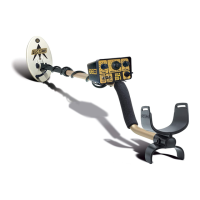10
31
EMI is usually easier to control in the All Metal Mode than in the Discrimination Mode.
On the Gold Bug
®
, setting the discrimination level between 60 and 70 will usually reduce
interference. In the Discrimination Mode, the detector may chatter if the searchcoil is
not in motion, but once you start sweeping it over the ground, the signal from the ground
will usually suppress the EMI chatter, except for an occasional pop or click which will not
sound like a real target.
If you are conducting an indoor demonstration, you may find that changing the
orientation of the searchcoil will reduce the pickup of EMI.
If you carry a cell phone or other high-tech electronic equipment while metal detecting
and you encounter EMI, try turning the device off and see if that solves the problem.
Turn such devices completely off, not just into standby mode.
When working near overhead power lines, you may get the best results right under the
power line and the worst results when standing at a 30° to 45° angle to the power line.
Many sources of EMI are intermittent. You may find that an area which is difficult to
search at one time of day may be easier after 5 PM, or on weekends. Power lines are
usually quietest late at night, and on weekend mornings.
Small searchcoils usually pick up less EMI than larger searchcoils. On a site with severe
electrical interference, a small searchcoil is often a better choice than a large one.
Distinguishing Electromagnetic Interference (EMI) from other problems
EMI will often vary as you walk around from place to place, and it will also vary with
changes in the orientation of the searchcoil. This is almost never the case if there is a
functional problem with the metal detector itself.
The most common cause of a noisy metal detector, where the problem is not EMI, is a
defective searchcoil. If striking the searchcoil with your hand causes the noise to start
or stop, the problem could be a defective searchcoil. Also, a defective searchcoil often
causes noise of a more intermittent nature than electrical interference.
The second most common cause is a loose searchcoil connector. The noise from a
loose connector will usually be very erratic or intermittent in nature. Try unplugging the
searchcoil and then reconnecting it to ensure the connector is firmly installed.
If you use a searchcoil cover, dirt or water can accumulate inside it, and movement of
those materials can cause false signals while sweeping the searchcoil. Searchcoil
covers must be periodically removed and cleaned.
ELECTRICAL INTERFERENCE (EMI)
X. Click the MODE knob to the right
The detector is now in the All Metal Mode
a. Keep GAIN set at the 12:00 position
b. Rotate the THRESHOLD knob slowly from the far counterclockwise
position to the full clockwise position.
Notice these attributes of the THRESHOLD control, with no metal
over the searchcoil.
i. at low settings you will hear no sound
ii. at mid-scale, there will be a transition point from no sound to
a barely audible, choppy sound.
iii. at full scale you will hear a loud, constant tone. It may also have
an irregular or choppy sound, as a result of Electromagnetic
Interference (EMI) emitted from other electrical devices.
Use with headphones
(not included)
The Gold Bug
®
is equipped with a 1/4” headphone jack. Any headphones with a
stereo plug will work; headphones with a mono plug will not work. Using
headphones extends battery life, and also prevents the sounds from bothering
bystanders. It also allows you to hear subtle changes in the sound more clearly,
particularly if searching in a noisy location. Gold nuggets are often very small, so
closely monitoring changes in sound using headphones will improve your gold
prospecting results. For safety reasons, do not use headphones near traffic or
where other dangers, like rattlesnakes, are present. This device is to be used with
interconnecting cables/headphone cables shorter than three meters.
IX. Press-and-hold and hold the nickel over the searchcoil
a. Notice that motion is not required.
A motionless object induces a hum.
b. Notice the variable pitch & volume hum.
c. Move the nickel closer to and farther away from the searchcoil.
Notice the changing “depth” values.
QUICK-START DEMONSTRATION

